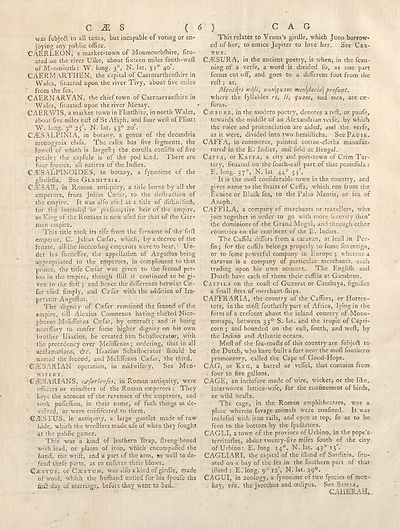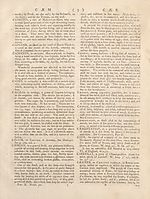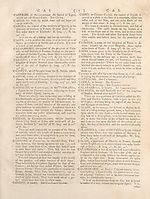Encyclopaedia Britannica; or, A dictionary of arts and sciences, compiled upon a new plan … > Volume 2, C-L
(14) Page 6
Download files
Complete book:
Individual page:
Thumbnail gallery: Grid view | List view

c s ( i
was fubjeft to all taxes, but incapable of voting or en¬
joying any public office.
CAERLEON, a market-town of Monmouthffiire, fitu-
ated on the river Uike, about fixteen miles fouth-weft
of Monmouth: W. long. 30, N. lat. 510 4c/.
CAERMARTHEN, the capital of Caermarthenffiire in
Wales, iituated upon the river Tivy, about five miles
from the fea.
CAERN ARYAN, the chief town of Caernarvanffiire in
Wales, fituated upon the river Menay.
CAERWIS, a market town in Flintffiire, in north Wales,
about five miles eaft of St Afaph, and four well of Flint:
W. long. 30 25', N. lat. 530 20'.
C2ESALPINIA, in botany, a genus of the decandria
monogynia clafs. The calix has five fegments, the
lowed of which is larged; the corolla eonfids of five
petals; the capfule is of the pod kind. There are
four fpecies, all natives of the Indies.
C .ESALPINOIDES, in botany, a fynonime of the
gleditfia. See Gleditsia.
■CjESAR, in Roman antiquity, a title borne by all the
emperors, fronii Julius Cssfar, to the dedru&ion of
the empire. It was alfo ufed as a title of didinftioft,
for the intended '6r prefumptive heir of the empire,
as King of the Romans is now ufed for that of the Ger¬
man empire.
This title took its rife from the furname of the fird
emperor, C. Julius Csefar, which, by a decree of the
fenate, all the fucceeding emperors were to bear. Un¬
der his fucceflbr, the appellation of Augudus being
appropriated to the emperors, in compliment to that
prince, the title Caefar was given to the fecond per-
ion in the empire, though dill it continued to be gi¬
ven to the fird ; and hence the difference betwixt C«-
far ufed Amply, and Caefar with the addition of Ira-
perator Augudus.
The dignity of Caefar remained the fecond of the
empire, till Alexius Comnenus having defied Nice-
phorus Meliffehus Caefar, by contradl ; and it being
neceffary to confer fome higher dignity on his own
brother Ifaacius, he created him Sebadocrator, with
the precedency over Meliffenus; ordering, that in all
acclamations, &c. Ifaacius Sebadocrator ffiould be
named the fecond, and Meliffenus Caefar, the third.
CAESARIAN operation, in midwifery. See Mid¬
wifery.
•C/E3ARIANS, c^farienfes, in Roman antiquity, were
officers or mioiders of the Roman emperors : They
kept the account of the revenues of the emperors, and
took poffeffion, in their name, of fuch things as de¬
volved, or were cohfifcated to them.
GVESTUS, in antiquity, a large gantlet made of raw
hide, which the wredlers made ufe of when they fought
at the public games.
This was a kind of leathern *drap, drengihened
with lead, or plates of Iron, which encompaffed the
hand, the wrid, and a part of the arm, asi well to de¬
fend thefe parts, as to enforce their blows.
Caistus, orCiESTUM, was alfo a kind of girdle, made
of wool, which the hufband untied for his fpoufe the
drift day of marriage, before they went to bed.
; ) C A G
This relates to Venus’s girdle, which Juno borrow*-
ed of her, to entice Jupiter to love her. See Ces-
tus.
CiESURA, in the ancient poetry, is when, in the fcan-
ning of a verfe, a word is divided fo, as one part
feems cut off, and goes to a different foot from the
red:; as,
Menti\ri no\li, nun\quam men\dacia\ profunt.
where the fyllables ri, li, quatn, and men, are cse-
furas.
Cassure, in the modern poetry, denotes a red, or paufe,
towards the middle of an Alexandrian verfe, by which
the voice and pronunciation are aided, and the verfe,
as it were, divided into two hemidichs. See Pause.
CAFFA, in commerce, painted cotton-cloths manufac¬
tured in the E. Indies, and fold at Bengal.
Caffa, or Kaffa, a city and port-town of Crim Tar¬
tary, fituated on the fouth-eall part of that peninfula :
E. long. 370, N. lat. 440 55'.
It is the mod confiderable town in the country, and
fives name to the draits of Caffa, which run from the
mxine or Black fea, to the Palus Meotis, or lea of
Azoph.
CAFFILA, a company of merchants or travellers, who
join together in order to go wirh more fecurity thro’
the dominions of the Grand Mogul, ana-through other
countries on the continent of the E. Indies.
The Caffila differs from a caravan, at lead in Per-
fk; for the caffila belongs properly to fome fovereign,
or to fome powerful company in Europe ; whereas a
caravan is a company of particular merchants, each
trading upon his own account. The Engliffi and
Dutch have each of them their caffila at Gambron.
Caffila on the coad of Guzerat or Cambaya, fignifies
a fmall fleet of merchant-ffiips.
CAFFRARIA, the country of the Caffers, or Hotten¬
tots, in the mod foutherly part of Africa, lying in the
form of a crefcent about the inland country of Mono-
motapa, between 35° S. lat. and the tropic of Capri¬
corn ; and bounded on the ead, fouth, and wed, by
the Indian and Atlantic oceans,
Mod of the fea-coads of this country are fubjetf to
the Dutch, who have built a fort near the mod fouthern-
promontory, called the Cape of Good-Hope.
CAG, or Keg, a barrel or veffel, that contains from
- four to five gallons.
CAGE, an inclofure made of wire, wickery or the like,
interwoven lattice-wife, for the confinement of birds,
or wild beads.
The cage, in the Roman amphitheatres, was a
place wherein favage animals were confined. It was
inclofed with iron rails, and open at top, fo as to be
feen to the bottom by the fpeflators.
CAGLI, a town of the province ofUrbino, in the pope’s*
territories, about twenty-five miles fouth of the city
ofUrbino: E. long. 140, N. lat. 430 i$'.
CAGLIARI, the capital of the ifland of Sardinia, fitu¬
ated on a bay of the fea in the fouthern part of that
ifland : E. long. 90 X2,) N. lat. 390.
CAGUI, in zoology, a fynonime of two fpecies of mon¬
key, viz. the jaccchus and cedipus. See Simia,
CAHERAH,
was fubjeft to all taxes, but incapable of voting or en¬
joying any public office.
CAERLEON, a market-town of Monmouthffiire, fitu-
ated on the river Uike, about fixteen miles fouth-weft
of Monmouth: W. long. 30, N. lat. 510 4c/.
CAERMARTHEN, the capital of Caermarthenffiire in
Wales, iituated upon the river Tivy, about five miles
from the fea.
CAERN ARYAN, the chief town of Caernarvanffiire in
Wales, fituated upon the river Menay.
CAERWIS, a market town in Flintffiire, in north Wales,
about five miles eaft of St Afaph, and four well of Flint:
W. long. 30 25', N. lat. 530 20'.
C2ESALPINIA, in botany, a genus of the decandria
monogynia clafs. The calix has five fegments, the
lowed of which is larged; the corolla eonfids of five
petals; the capfule is of the pod kind. There are
four fpecies, all natives of the Indies.
C .ESALPINOIDES, in botany, a fynonime of the
gleditfia. See Gleditsia.
■CjESAR, in Roman antiquity, a title borne by all the
emperors, fronii Julius Cssfar, to the dedru&ion of
the empire. It was alfo ufed as a title of didinftioft,
for the intended '6r prefumptive heir of the empire,
as King of the Romans is now ufed for that of the Ger¬
man empire.
This title took its rife from the furname of the fird
emperor, C. Julius Csefar, which, by a decree of the
fenate, all the fucceeding emperors were to bear. Un¬
der his fucceflbr, the appellation of Augudus being
appropriated to the emperors, in compliment to that
prince, the title Caefar was given to the fecond per-
ion in the empire, though dill it continued to be gi¬
ven to the fird ; and hence the difference betwixt C«-
far ufed Amply, and Caefar with the addition of Ira-
perator Augudus.
The dignity of Caefar remained the fecond of the
empire, till Alexius Comnenus having defied Nice-
phorus Meliffehus Caefar, by contradl ; and it being
neceffary to confer fome higher dignity on his own
brother Ifaacius, he created him Sebadocrator, with
the precedency over Meliffenus; ordering, that in all
acclamations, &c. Ifaacius Sebadocrator ffiould be
named the fecond, and Meliffenus Caefar, the third.
CAESARIAN operation, in midwifery. See Mid¬
wifery.
•C/E3ARIANS, c^farienfes, in Roman antiquity, were
officers or mioiders of the Roman emperors : They
kept the account of the revenues of the emperors, and
took poffeffion, in their name, of fuch things as de¬
volved, or were cohfifcated to them.
GVESTUS, in antiquity, a large gantlet made of raw
hide, which the wredlers made ufe of when they fought
at the public games.
This was a kind of leathern *drap, drengihened
with lead, or plates of Iron, which encompaffed the
hand, the wrid, and a part of the arm, asi well to de¬
fend thefe parts, as to enforce their blows.
Caistus, orCiESTUM, was alfo a kind of girdle, made
of wool, which the hufband untied for his fpoufe the
drift day of marriage, before they went to bed.
; ) C A G
This relates to Venus’s girdle, which Juno borrow*-
ed of her, to entice Jupiter to love her. See Ces-
tus.
CiESURA, in the ancient poetry, is when, in the fcan-
ning of a verfe, a word is divided fo, as one part
feems cut off, and goes to a different foot from the
red:; as,
Menti\ri no\li, nun\quam men\dacia\ profunt.
where the fyllables ri, li, quatn, and men, are cse-
furas.
Cassure, in the modern poetry, denotes a red, or paufe,
towards the middle of an Alexandrian verfe, by which
the voice and pronunciation are aided, and the verfe,
as it were, divided into two hemidichs. See Pause.
CAFFA, in commerce, painted cotton-cloths manufac¬
tured in the E. Indies, and fold at Bengal.
Caffa, or Kaffa, a city and port-town of Crim Tar¬
tary, fituated on the fouth-eall part of that peninfula :
E. long. 370, N. lat. 440 55'.
It is the mod confiderable town in the country, and
fives name to the draits of Caffa, which run from the
mxine or Black fea, to the Palus Meotis, or lea of
Azoph.
CAFFILA, a company of merchants or travellers, who
join together in order to go wirh more fecurity thro’
the dominions of the Grand Mogul, ana-through other
countries on the continent of the E. Indies.
The Caffila differs from a caravan, at lead in Per-
fk; for the caffila belongs properly to fome fovereign,
or to fome powerful company in Europe ; whereas a
caravan is a company of particular merchants, each
trading upon his own account. The Engliffi and
Dutch have each of them their caffila at Gambron.
Caffila on the coad of Guzerat or Cambaya, fignifies
a fmall fleet of merchant-ffiips.
CAFFRARIA, the country of the Caffers, or Hotten¬
tots, in the mod foutherly part of Africa, lying in the
form of a crefcent about the inland country of Mono-
motapa, between 35° S. lat. and the tropic of Capri¬
corn ; and bounded on the ead, fouth, and wed, by
the Indian and Atlantic oceans,
Mod of the fea-coads of this country are fubjetf to
the Dutch, who have built a fort near the mod fouthern-
promontory, called the Cape of Good-Hope.
CAG, or Keg, a barrel or veffel, that contains from
- four to five gallons.
CAGE, an inclofure made of wire, wickery or the like,
interwoven lattice-wife, for the confinement of birds,
or wild beads.
The cage, in the Roman amphitheatres, was a
place wherein favage animals were confined. It was
inclofed with iron rails, and open at top, fo as to be
feen to the bottom by the fpeflators.
CAGLI, a town of the province ofUrbino, in the pope’s*
territories, about twenty-five miles fouth of the city
ofUrbino: E. long. 140, N. lat. 430 i$'.
CAGLIARI, the capital of the ifland of Sardinia, fitu¬
ated on a bay of the fea in the fouthern part of that
ifland : E. long. 90 X2,) N. lat. 390.
CAGUI, in zoology, a fynonime of two fpecies of mon¬
key, viz. the jaccchus and cedipus. See Simia,
CAHERAH,
Set display mode to:
![]() Universal Viewer |
Universal Viewer | ![]() Mirador |
Large image | Transcription
Mirador |
Large image | Transcription
Images and transcriptions on this page, including medium image downloads, may be used under the Creative Commons Attribution 4.0 International Licence unless otherwise stated. ![]()
| Encyclopaedia Britannica > Encyclopaedia Britannica; or, A dictionary of arts and sciences, compiled upon a new plan … > Volume 2, C-L > (14) Page 6 |
|---|
| Permanent URL | https://digital.nls.uk/144913792 |
|---|
| Attribution and copyright: |
|
|---|
| Description | Ten editions of 'Encyclopaedia Britannica', issued from 1768-1903, in 231 volumes. Originally issued in 100 weekly parts (3 volumes) between 1768 and 1771 by publishers: Colin Macfarquhar and Andrew Bell (Edinburgh); editor: William Smellie: engraver: Andrew Bell. Expanded editions in the 19th century featured more volumes and contributions from leading experts in their fields. Managed and published in Edinburgh up to the 9th edition (25 volumes, from 1875-1889); the 10th edition (1902-1903) re-issued the 9th edition, with 11 supplementary volumes. |
|---|---|
| Additional NLS resources: |
|

